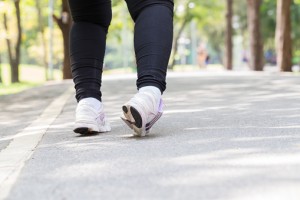


Sprained ankle risk may be influenced by foot positioning during walking and running. The findings from researchers at the University of Georgia found that the position of the foot when walking or running could greatly affect the likelihood of spraining the ankle.
The findings of the study showed that people with a history of ankle sprains had a lower clearance height between their feet and the floor during running and pointed their toes more during walking. Many individuals who experience ankle sprains will go on to have chronic instability and have a higher likelihood of frequent future sprains as well.
Lead author Cathleen Brown Crowell said, “Almost everyone who is physically active will suffer an ankle sprain at some point. Many people develop repetitive ankle injuries that are painful, can decrease performance and increase the risk of ankle osteoarthritis. We were able to identify factors in foot positioning prior to contact with the ground that may predispose some people to these repetitive injuries. These findings can help clinicians develop rehabilitation programs that address movements that may have been ignored in the past.”
The study looked at data from over 30 male recreational athletes with a history of repetitive ankle sprains and some men without. Motion capture equipment allowed researchers to observe joint mobility and force while the men walked or ran.
Brown Crowell concluded, “We can apply our findings to clinical practice. Our study demonstrates there are differences in movements at the foot and ankle in an injured population that may respond to rehabilitation interventions beyond typical stretching and strengthening. The next step is to see if targeted interventions, trying to influence how people run and walk, can treat and even prevent ankle sprains.”
A common cause for ankle sprains is a rapid change in motion when the foot is planted. Ankle sprains are commonly seen in sporting activities, as there is a higher frequency for sudden motion changes. The ankle will either roll inward or outward, causing the ligaments to become stretched and tear.
The severity of an ankle sprain can range greatly, depending on the ligament damage caused. In cases of a minor sprain, the individual will still feel stable, but in pain. In a severe sprain, the individual would not be able to apply any pressure to the foot, thus having difficulty walking.
Symptoms of a sprain include swelling, pain in the affected area, bruising, and difficulty or inability to move the foot.
Immediately and a few days after ankle sprain, it’s important that you rest and ice it as much as possible. Once you have the okay from your doctor and you’re not in too much pain, you can begin ankle exercises in order to strengthen the ankle once more.
At first, you may be only able to perform ankle exercises once or twice, but as your ankle becomes stronger and begins to heal, you can increase the frequency of the exercises. Sprained ankle exercises include:
Aside from exercises, there are other home remedies you can do in order to speed up healing and reduce the pain and discomfort that come along with a sprained ankle. Sprained ankle home remedies include:
Pairing these home remedies with ankle exercise, you can help shorten the duration of the injury and get back to moving once again.
Joint pain? Drink this…
Aches and pains are somewhat of a normal occurrence the older we become, whether it is due to joint overuse or arthritis. With the onset of pain, many of us simply take some anti-inflammatory medications a few times a day, which allows us to carry on. Unfortunately though, there is growing evidence that long-term use of such medication can be quite harmful to the body. Continue reading…
Prevent shin splints: Reduce pain in the lower leg
Preventing shin splints is a good way to reduce the pain that you feel in your lower leg. Shin splints refer to the pain that is felt along the shinbone, or tibia. This is a large bone that runs along the front of your leg from your knee to your ankle. Sin splints are commonly seen in runners, dancers, and military recruits. Continue reading…
Copyright © www.orthopaedics.win Bone Health All Rights Reserved